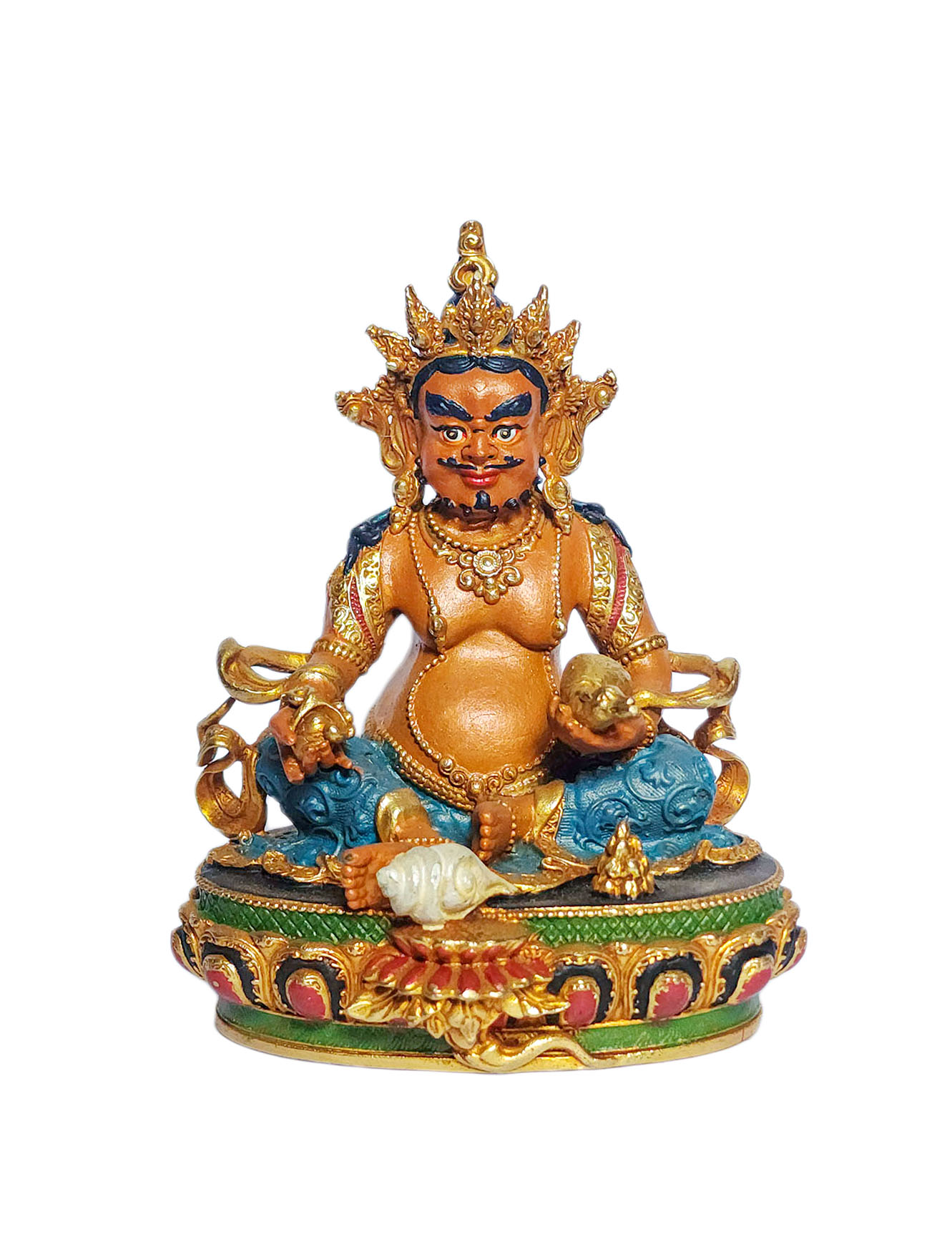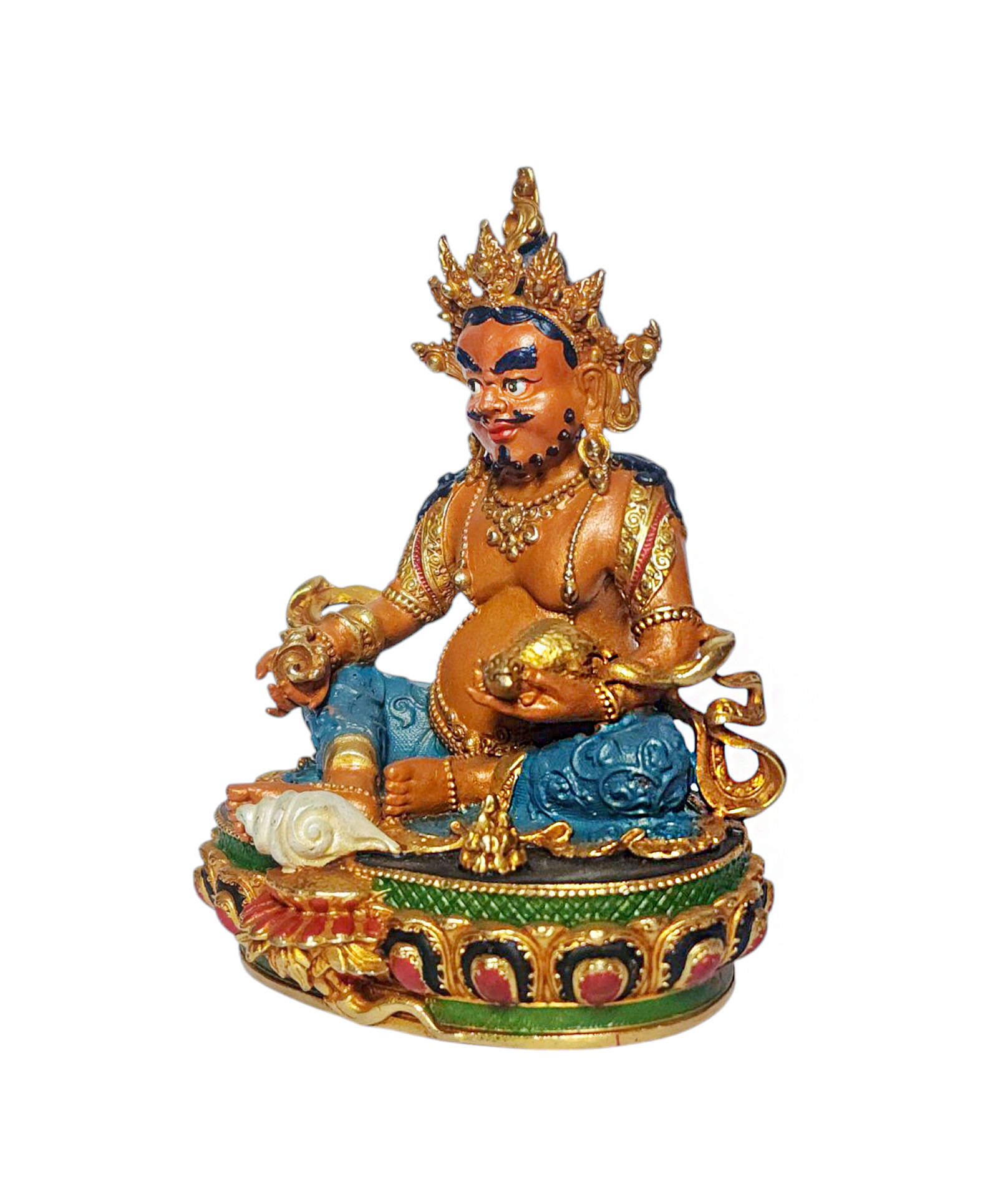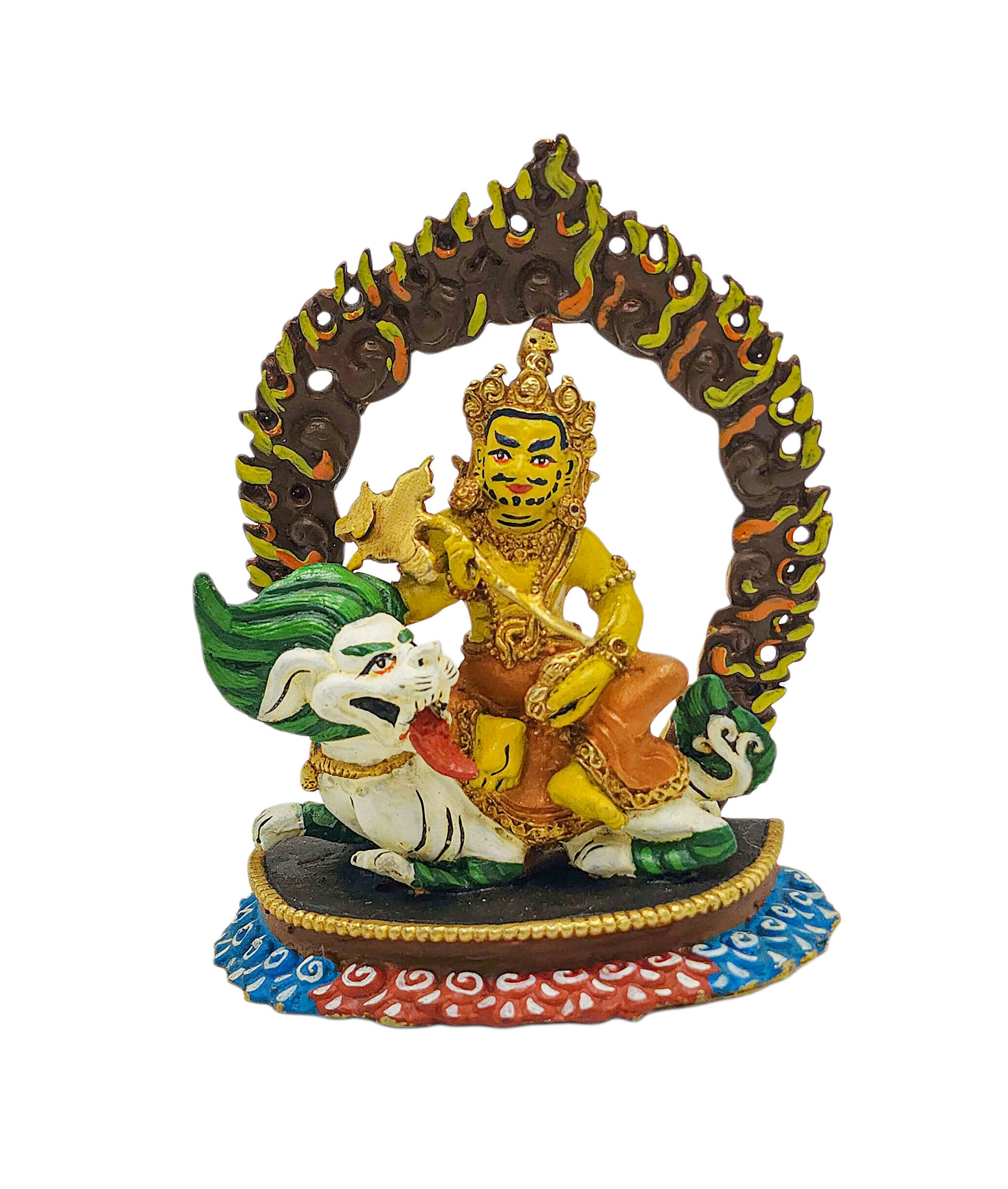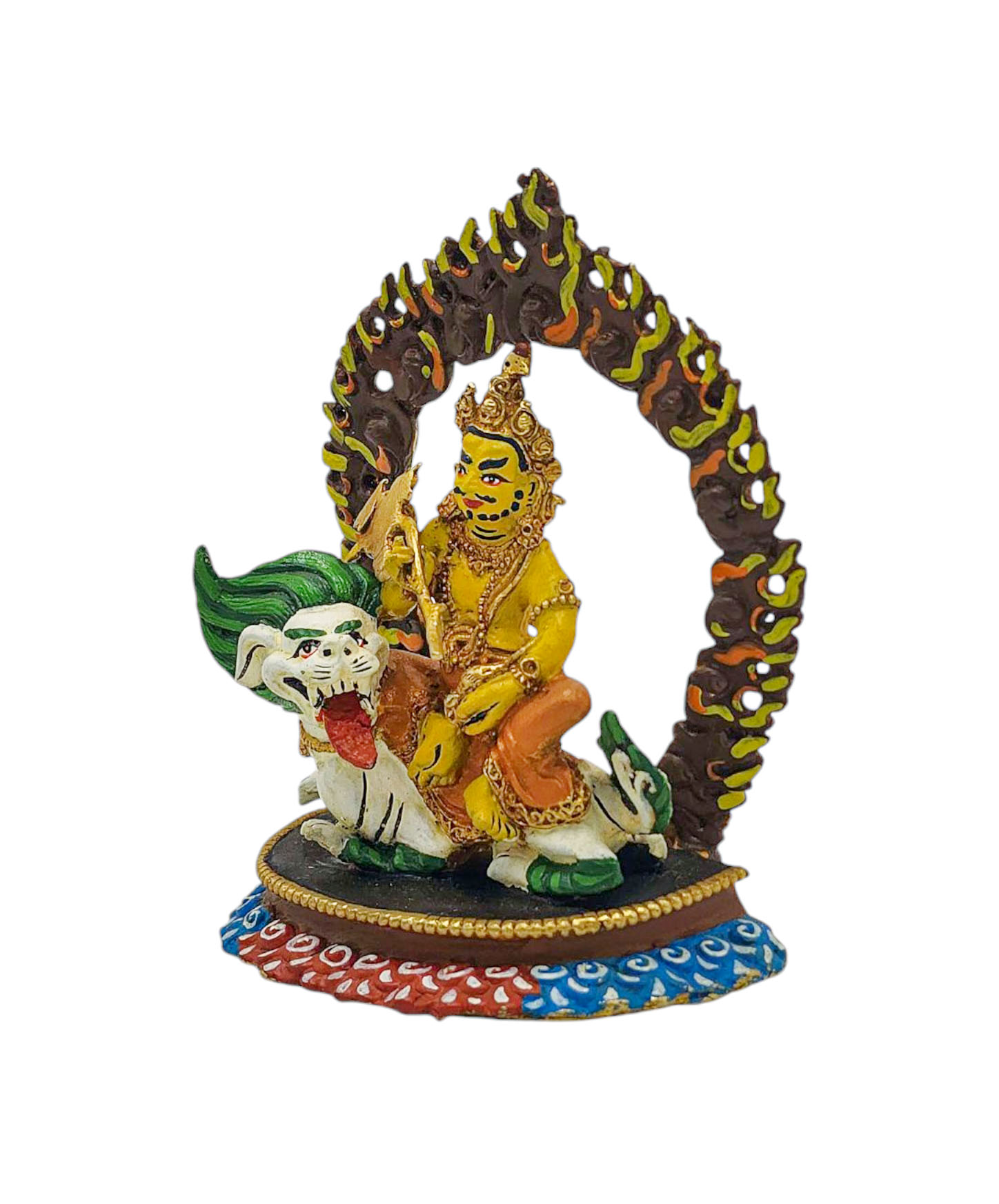Code
HCS35422
Weight
115 gm / 0.25 lbs
Size
Height
8cm (3") Width
6cm (2") Depth
4cm (2") Material
Copper
Availability
Available

Safe Payment
We accept Paypal, Money Transfer, Bank Transfer
Confidence
Protection covers your purchase and personal data.
Worldwide Delivery
We ship Worldwide, except Russia.Shipping cost US$25.2 for upto 0.5 kgs

Hotline
Talk to help line for your question on 9841267335Gold Painted Face
The face of [lakshmi], Buddhist Miniature Statue, [thangka Color Finishing], [face Painted] is painted with gold to enhance its significant features, particularly the eyes, and lips. This detailed painting is essential as it brings forth the crucial attributes of the expression of eyes and lips that metal carving alone cannot capture.
Moreover, the painted face serves as a symbolic and sacred ritual in Buddhism, preparing the statue for consecration and practice. The act of painting the face with gold in Buddhism holds deep meaning. It represents the intention to bring life and expression to the statue, imbuing it with a sense of vitality and presence. The application of gold on the face showcases the devotion and craftsmanship of the artisans, ensuring that every detail is carefully attended to honor the sacred essence of the [lakshmi], Buddhist Miniature Statue, [thangka Color Finishing], [face Painted]. Read More . . .
The face of [lakshmi], Buddhist Miniature Statue, [thangka Color Finishing], [face Painted] is painted with gold to enhance its significant features, particularly the eyes, and lips. This detailed painting is essential as it brings forth the crucial attributes of the expression of eyes and lips that metal carving alone cannot capture.
Moreover, the painted face serves as a symbolic and sacred ritual in Buddhism, preparing the statue for consecration and practice. The act of painting the face with gold in Buddhism holds deep meaning. It represents the intention to bring life and expression to the statue, imbuing it with a sense of vitality and presence. The application of gold on the face showcases the devotion and craftsmanship of the artisans, ensuring that every detail is carefully attended to honor the sacred essence of the [lakshmi], Buddhist Miniature Statue, [thangka Color Finishing], [face Painted]. Read More . . .
About Color Finishing
The [lakshmi], Buddhist Miniature Statue, [thangka Color Finishing], [face Painted] is adorned with traditional colors, creating a captivating aesthetic through a combination of gold and various hues. This painting technique follows a time-honored process that aims to faithfully represent the [lakshmi], Buddhist Miniature Statue, [thangka Color Finishing], [face Painted] in accordance with traditional color descriptions. In the context of Buddhist statues, this approach holds great significance. Each statue has its own primary color, and it is crucial to depict the statue in its authentic shade. Read More . . .
The [lakshmi], Buddhist Miniature Statue, [thangka Color Finishing], [face Painted] is adorned with traditional colors, creating a captivating aesthetic through a combination of gold and various hues. This painting technique follows a time-honored process that aims to faithfully represent the [lakshmi], Buddhist Miniature Statue, [thangka Color Finishing], [face Painted] in accordance with traditional color descriptions. In the context of Buddhist statues, this approach holds great significance. Each statue has its own primary color, and it is crucial to depict the statue in its authentic shade. Read More . . .
Ceramic Molding System
The [lakshmi], Buddhist Miniature Statue, [thangka Color Finishing], [face Painted] has been crafted using the Ceramic mold casting process, a modern approach that provides an alternative to traditional methods such as the lost-wax system or rubber molding. Also referred to as ceramic molding, this technique involves the creation of a ceramic mold to cast the statue. The process begins by making a precise and detailed wax model of the desired sculpture. The wax model is then coated with layers of ceramic material, creating a sturdy mold. Once the mold is complete, it is fired in a kiln, causing the wax to melt and escape, leaving behind a cavity that perfectly replicates the original sculpture. Molten metal is then poured into the mold, allowing it to fill the cavity and take on the desired form. Once cooled and solidified, the ceramic mold is carefully broken away, revealing the final metal statue. Read More . . .
The [lakshmi], Buddhist Miniature Statue, [thangka Color Finishing], [face Painted] has been crafted using the Ceramic mold casting process, a modern approach that provides an alternative to traditional methods such as the lost-wax system or rubber molding. Also referred to as ceramic molding, this technique involves the creation of a ceramic mold to cast the statue. The process begins by making a precise and detailed wax model of the desired sculpture. The wax model is then coated with layers of ceramic material, creating a sturdy mold. Once the mold is complete, it is fired in a kiln, causing the wax to melt and escape, leaving behind a cavity that perfectly replicates the original sculpture. Molten metal is then poured into the mold, allowing it to fill the cavity and take on the desired form. Once cooled and solidified, the ceramic mold is carefully broken away, revealing the final metal statue. Read More . . .
Brief Introduction :
Lakshmi is the Hindu goddess of wealth, prosperity (both material and spiritual), light, wisdom, fortune, fertility, generosity and courage; and the embodiment of beauty, grace and charm. Representations of Lakshmi are also found in Jain monuments. Also called Mahalakshmi, she is said to bring good luck, and is believed to protect her devotees from all kinds of misery and money-related sorrows.
Lakshmi in Sanskrit is derived from its elemental form lakS, meaning "to perceive or observe". This is synonymous with lakṣya, meaning "aim" or "objective". The Hindu sacred texts, the Vedas call Mahalakshmi as Lakshyayidhi Lakshmihi which means she is the one who has the object and aim of uplifting mankind.
Iconography :Lakshmi in Sanskrit is derived from its elemental form lakS, meaning "to perceive or observe". This is synonymous with lakṣya, meaning "aim" or "objective". The Hindu sacred texts, the Vedas call Mahalakshmi as Lakshyayidhi Lakshmihi which means she is the one who has the object and aim of uplifting mankind.
Lakshmi is described as bestowing coins of prosperity and flanked by elephants signifying her royal power. However, in some texts, she has an owl as her vahana. Her expression is always calm and loving. The lotus also symbolizes the fertile growth of organic life, as the world is continually reborn on a lotus growing out of Vishnu's navel.
Lakshmi is worshipped daily, but special focus is given in the month of October. Her worship ceremonies include people offering food and sweets, chanting her 108 names, prayers repeated, and devotional songs being sung.
Mantra :Lakshmi is worshipped daily, but special focus is given in the month of October. Her worship ceremonies include people offering food and sweets, chanting her 108 names, prayers repeated, and devotional songs being sung.
oṃ śrīṃ hrīṃ klīṃ tribhuvana mahālakṣmyai asmākam dāridrya nāśaya pracura dhana dehi dehi klīṃ hrīṃ śrīṃ oṃ ।


![[lakshmi], Buddhist Miniature Statue, [thangka Color Finishing], [face Painted]](https://handmadeexpo.com/pics/product/thumb/35422.jpg)
![[lakshmi], Buddhist Miniature Statue, [thangka Color Finishing], [face Painted]](https://www.handmadeexpo.com/pics/product/thumb/35422_0.jpg)
![[lakshmi], Buddhist Miniature Statue, [thangka Color Finishing], [face Painted]](https://www.handmadeexpo.com/pics/product/thumb/35422_1.jpg)
![[lakshmi], Buddhist Miniature Statue, [thangka Color Finishing], [face Painted]](https://www.handmadeexpo.com/pics/product/thumb/35422_2.jpg)
![[lakshmi], Buddhist Miniature Statue, [thangka Color Finishing], [face Painted]](https://www.handmadeexpo.com/pics/product/thumb/35422_3.jpg)

 Amitabha Buddha, Buddhist Miniature Statue,
Amitabha Buddha, Buddhist Miniature Statue,  Amitabha Buddha, Buddhist Miniature Statue,
Amitabha Buddha, Buddhist Miniature Statue,  Yellow Jambhala, Buddhist Miniature Statue,
Yellow Jambhala, Buddhist Miniature Statue,  Yellow Jambhala, Buddhist Miniature Statue,
Yellow Jambhala, Buddhist Miniature Statue,  White Jambhala, Buddhist Miniature Statue,
White Jambhala, Buddhist Miniature Statue,  White Jambhala, Buddhist Miniature Statue,
White Jambhala, Buddhist Miniature Statue,  of Aparimita,
of Aparimita,  of Aparimita,
of Aparimita, 
 Yellow Jambhala, Buddhist Miniature Statue,
Yellow Jambhala, Buddhist Miniature Statue,  Yellow Jambhala, Buddhist Miniature Statue,
Yellow Jambhala, Buddhist Miniature Statue,  Jambhala: Namtose, Buddhist Miniature Statue,
Jambhala: Namtose, Buddhist Miniature Statue,  Jambhala: Namtose, Buddhist Miniature Statue,
Jambhala: Namtose, Buddhist Miniature Statue,  Aparimita, Buddhist Miniature Statue,
Aparimita, Buddhist Miniature Statue,  Aparimita, Buddhist Miniature Statue,
Aparimita, Buddhist Miniature Statue,  Ganesh, Buddhist Miniature Statue,
Ganesh, Buddhist Miniature Statue,  Ganesh, Buddhist Miniature Statue,
Ganesh, Buddhist Miniature Statue,  Traditional Color Finishing, Chepame, Amitayus" title="Aparimita Handmade Statue
Traditional Color Finishing, Chepame, Amitayus" title="Aparimita Handmade Statue  Traditional Color Finishing, Chepame, Amitayus" title="Aparimita Handmade Statue
Traditional Color Finishing, Chepame, Amitayus" title="Aparimita Handmade Statue